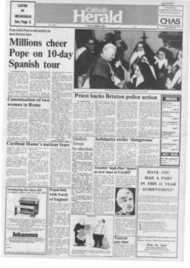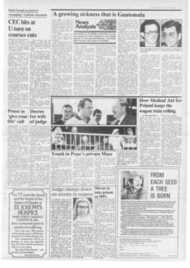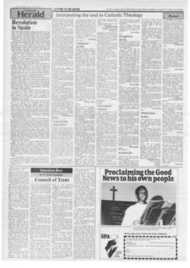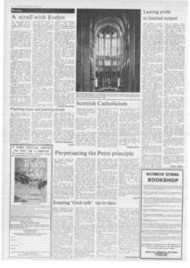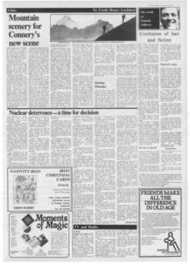Page 7, 5th November 1982
Page 7

Report an error
Noticed an error on this page?If you've noticed an error in this article please click here to report it.
Tags
Share
Related articles
Jack's Back In The Rat Race
A Saint,a Nazi Fugitive And A Multitude Of Ants
Gallant And Gentle Cinema Critic
'a Truly Captivated Audience'
Films by Freda Bruce Lockhart
Mountain scenery for Connery's new scene
FRED Zinnemann's Five Days One Summer ("A", Warner) arrived rather as a postscript to the recent Zinnemann season at the National Film Theatre. It forms a distinguished prelude to the London Film Festival which opens next Thursday and of which the film is not part.
Zinnemann has been one of my most favoured and admired directors since at least "The Search", his compassionate post-war movie which starred Montgomery Clift and Yvonne Mitchell. Zinnemann's style is classical, his taste and craftsmanship impeccable.
Five Days may not be one of the greatest. The simple short story by Kay Boyle had lain in his mind for thirty years. As in most of Zinnemann's films, it is his mastery of perception and setting which achieves the quality. The story is frail enough. A middle-aged tweedy married Scots doctor (Sean Connery) takes a young girl Kate (Betsy Brantley) for a climbing holiday in Switzerland. When they are alloted a nice young Swiss guide (Lambert Wilson) instant suspicion is aroused that the latter will fall in love with her. So he does, but even when the obvious happens, it doesn't happen obviously. It happens gradually and with restraint as even the background and the detail of the relationship is only gradually filled in, with the love affair dwarfed and dominated by the . majestic mountains all round. The gentle charm of both Connery and Betsy Brantley is as watchable as the pastoral green slopes of the mountain. A climax does come when the two men set out with ropes to conquer a peak. There is an accident and Kate watches anxiously to see which one returns. We watch too, knowing neither which it will be, not' which she wants it to be.
Scenic beauty is one of the assets and attractions of Five Days One Summer. The same is true of a very different movie, Race for the Yankee Zephyr ("A" Classic, Haymarket). This again is not at all what you might expect, if the title suggests baseball team. It is in fact a rumbustious treasure hunt for a boatload of hidden gold, a lusty knockabout search by a mixed pack of helicopters. What made it enthralling for me was not so much the vigour and action of the search as the superb New Zealand lake and mountain scenery. This makes the movie refreshing and invigorating as much as the performance of
Donald Pleasence all out for comedy keeps up laughter.
People often think me thickskinned for not caring much about violence on the screen. The point is that I hardly care what I see done to actors and other professional people who are paid to take part in barbarities and can choose not to. But I can hardly bear to think of, let alone to see, animals subjected to human brutality. Recent letters to the Catholic Herald suggested that many readers experience a similar sense of shame over what is commonly regarded as Catholic realism on this point. People who feel like this may quail at the thought of The Plague Dogs ("A" Odeon, Haymarket) an animated version of Richard Adams's book about two dogs who escape from an animal research establishment in the lake district and are thought to be chasing sheep and spreading bacteria.
I don't think you need be afraid. I didn't greatly care for Richard Adams's Watership Down or the film of it. But The Plague Dogs does seem to me a perfectly sound story from the anti-vivisectionist standpoint and the drawing more solid than in the usual cartoon — more reminiscent of Halas and Batchelor's Animal Farm than of the usual Disney. Although they talk respectively in the voices of John Hurt and Christopher Benjamin, Snitter the lively fox terrier and Rowf, "mixed breed black labrador" are not over-sentimentalised. Rowf indeed is a bit of a bore probably due to his spirit having been broken by systematic immersion to test his capacity to withstand drowning but they convincingly make baddies of the "Whitecoats". I don't know whether children will love it, but realists of all ages (and they are often very young) should be able to stand it.
The real Disney studios — not Walt of course but his legal successors — have struck out in a different direction with Tron ("U", Odeon, Leicester Square). The title is the name of the hero of a new electronic universe of which I candidly understood nothing, so plead inability to judge. All I could tell was that the population, and so the cast, were divided between computers and programmes, under the malevolent mastery of Sark (David Warner) and overruled by MCP (Master Control Program) an electronic Big Brother. Generally they are dressed in mauvish-grey unisex skin-suits.
Even I could not fail to recognise the special effects as brilliant. So I watched in respectful, not to admit awestruck attention realising that serious matters were being played out though I only saw the film was coming to an end when two of the androgynous creatures in body-tights went into a closing clinch (Jeff Bridges and Cindy Morgan).
Under-fifteens will I'm sure understand the whole as easily as a football match and I expect them to enjoy it with as much satisfaction as if it were a genuine, authentic antique Disney cartoon.
blog comments powered by Disqus


